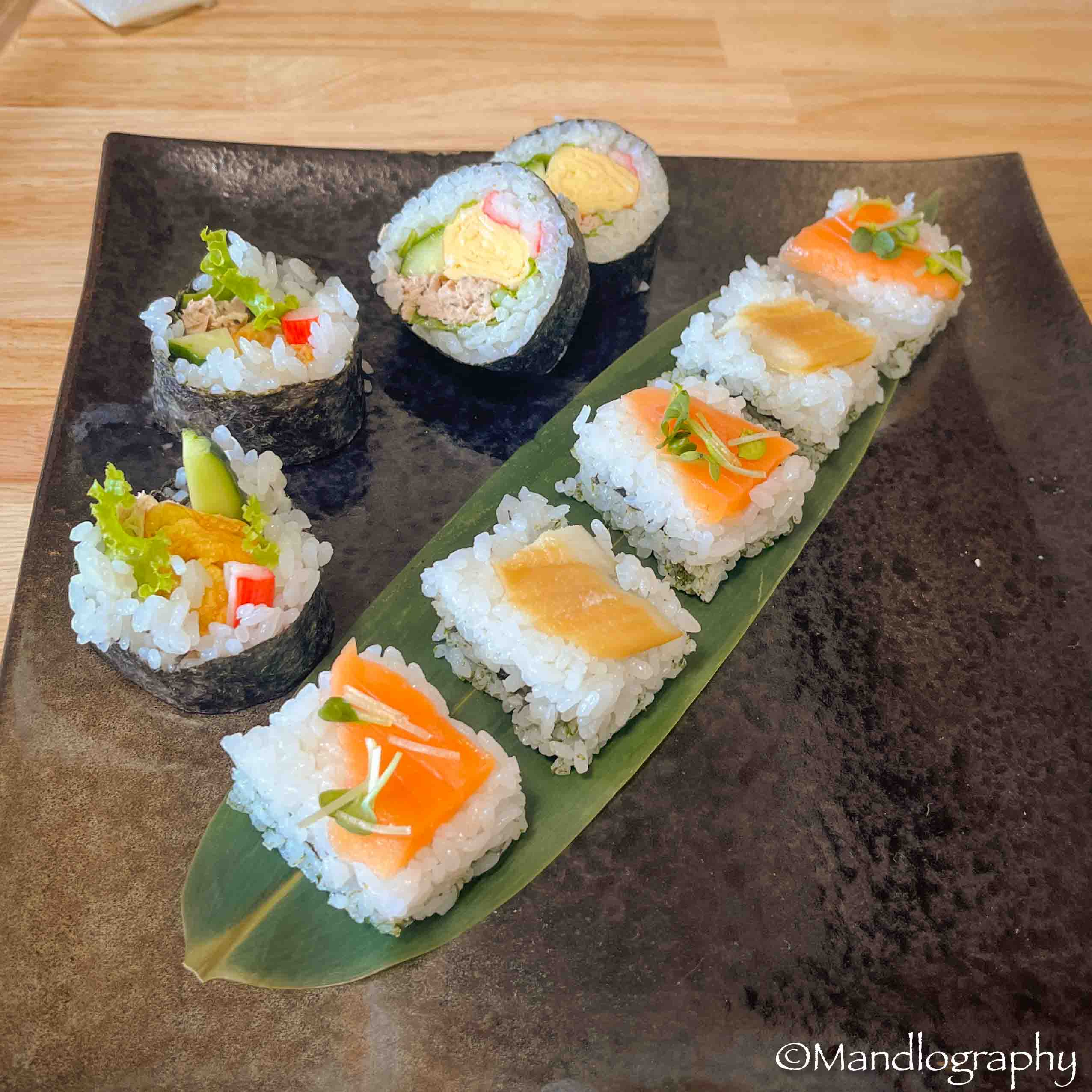Japan’s many culinary delights presented me with a delightful dilemma. Faced with a multitude of delicious options, I embarked on a foodventure to uncover the art of Japanese cooking. After searching for cooking classes, I stumbled upon Cooking Sun, Osaka. It was a culinary haven brimming with positive reviews. A crucial choice awaited: to master the art of crafting Ramen and Gyoza from scratch or to create sushi? With both options being beloved Japanese classics, the decision was anything but straightforward. Ultimately, my desire to conquer the art of sushi tipped the scales.
My sushi-making journey led me to an apartment block nestled in the heart of Dotonburi, a stone’s throw from the vibrant Kuromon Market. The cooking studio was spacious and impeccably arranged with various Japanese cooking utensils. I discovered a few cooking tools I’d never encountered before. In the company of two fellow enthusiasts, an intimate class began to take shape.
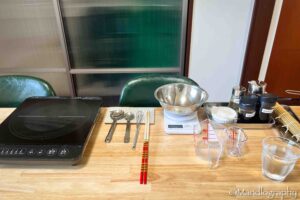
Our initial exchange was one of introductions. We were all travelling across Japan for varying durations, and we regaled each other with tales of our adventures. We forged an immediate connection due to our shared passion for Japanese cuisine. We discussed the many options in Japan, which exceeded what we found at home. Our chatter prompted a gentle reminder from our instructor that our mission extended beyond conversation; it was time to create. On the menu was miso soup, pressed sushi, rolled sushi as well as hand rolled sushi.
Our culinary voyage commenced with the creation of dashi. It is the foundational Japanese stock soup comprising kelp (seaweed), dried bonito (tuna flakes) and with mushroom. This simple yet essential start set the stage for our culinary exploration. The instructor then unveiled the world of miso. Did you know that there was a yellow, white, and red miso? It was news to me. The temperature, malt, and preparation time determine the colour of each. The intensity of flavour ranged from mild to robust, with the red being the most robust. When preparing miso soup, one can also add tofu, radish, seaweed, or mushroom to customise the soup.
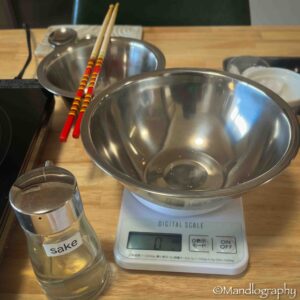
The core element of the sushi is the rice. As it rice needs to be cooked and cooled prior to making sushi, the instructor had prepared this ahead of time. She emphasised the need to use Japanese rice. As other rice variations may not give the desired consistency. We added rice vinegar, sugar and salt to the rice before fluffing it up while also trying to make sure that the rice was firm and not soggy. A fan proved to be an unexpected handy tool in the process.
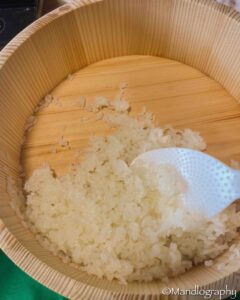

Next we prepared various sushi toppings. This included tiger prawn, tuna mayonnaise and assorted vegetables.
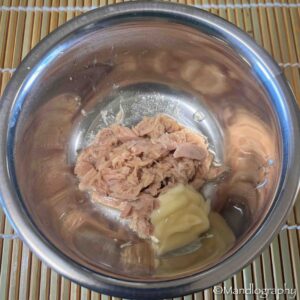
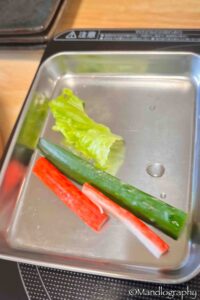
We prepared the iconic tomagoyaki (Japanese egg roll) on a flat iron pan. It seemed effortless when done by the instructor. My attempt at this with chopsticks was less seamless. I had to use all the delicacy and patience I could muster to ensure that the egg did not break. I took it out of the pan and held it on the rolling mat. This ensured that we had a nice round shape for the egg – an ode to aesthetics cherished in Japanese cuisine.
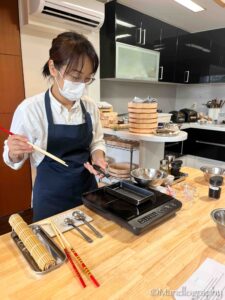


Our journey continued with preparing the rolled sushi. We learnt the importance of laying the nori correctly so that it did not break. As an attentive student, I lay the nori (dried seaweed) on the rolling mat, rough side up before adding a layer of sushi rice. I added lettuce, rolled egg, sliced cucumber, pepper, tuna mayo, crab sticks. I then rolled it firmly enough for a good shape, but delicate enough not to break the nori. As a student always aspiring for the top grade, I managed to get mine formed and structurally sound.
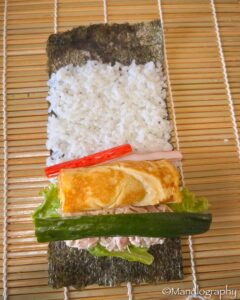
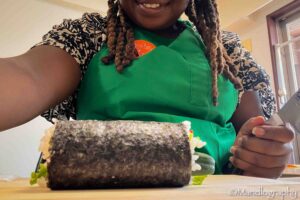
The next part of our journey was preparing pressed sushi. This sushi is celebrated for its simplicity, deliciousness and ease of preparation. It was fun to mix the rice with ground seaweed for the colour, then layered the ingredients on the sushi press. Precision guided our knife to align the sushi press’ contours. This variety, commonly enjoyed in Japanese households, now graced our plates as a testament to our growing expertise.
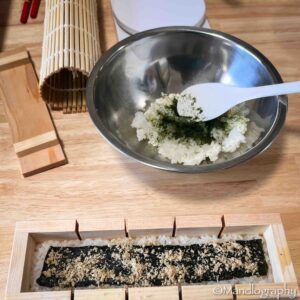
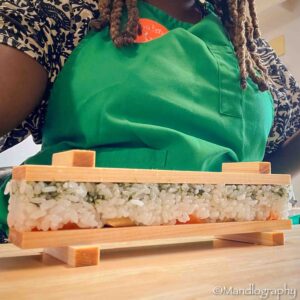
The pinnacle of our sushi-making adventure was the hand rolled sushi, which proved to be quite the challenge. Let me just say I will never complain about paying a bit more for those pieces of hand rolled sushi. Getting that perfect cuboid shape that would hold my toppings was not easy. Professional sushi chefs dedicate 5-10years in training. I’m sure a pretty chunk of that time is learning how to prepare hand rolled sushi.
In true Japanese style, we meticulously plated our sushi creating visually pleasing arrangements. It took a while for me to stop taking pictures and admiring the beautiful creations. We soon delved into the feast, complemented by a bowl of Miso soup. As someone with a profound appreciation for sushi, I could confidently say this experience ranked among my top 5 sushi meals.
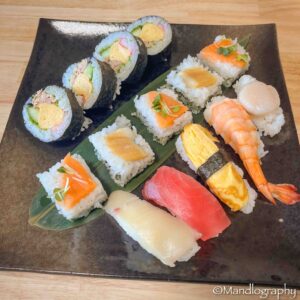
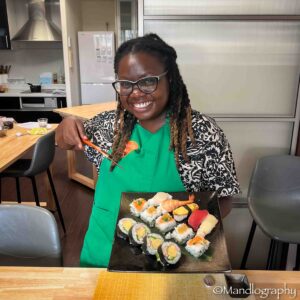
Menu included:
-Miso Soup
-Rolled sushi
-Pressed sushi
-Hand rolled sushi
Conclusion: The entire experience was about 3.5hrs long. It deserves a solid 9/10 rating. It was exceptional not only because of the intimate class size, but also the instructor’s profound knowledge about Japanese cooking and culture. Her valuable insights extended to practical tips for recreating sushi at home. The studio also offered the sale of some of the utensils used during the class. I could go on and make more sushi at home, with ease.
Have you ever tried making sushi at home? Would you go on this type of experience during your holiday?


